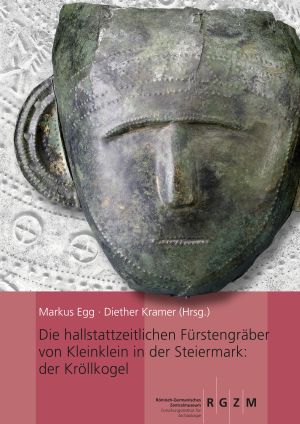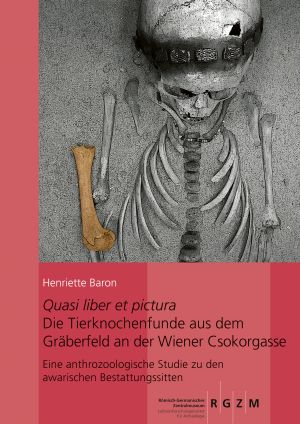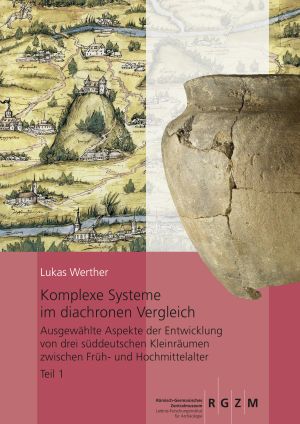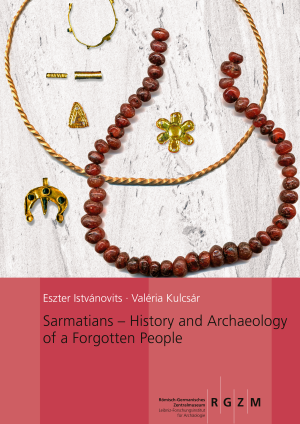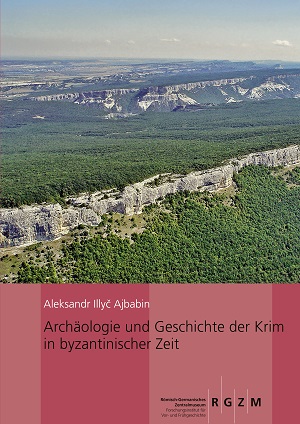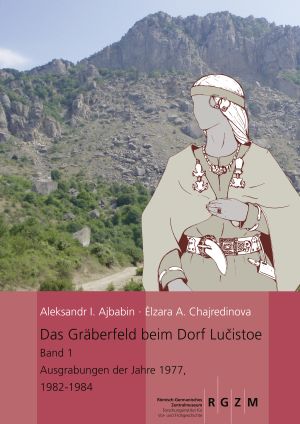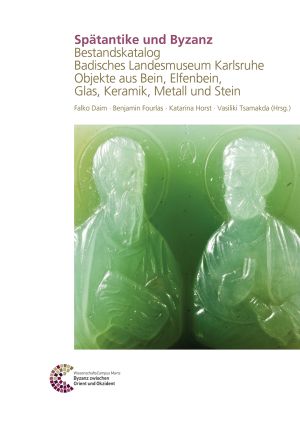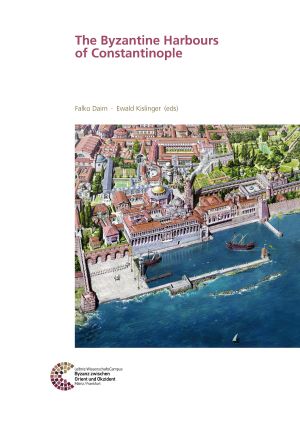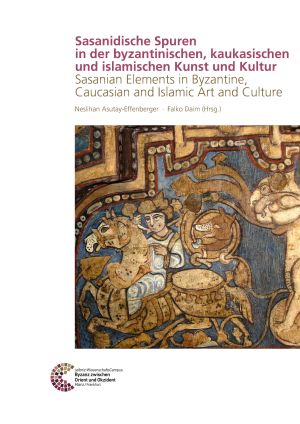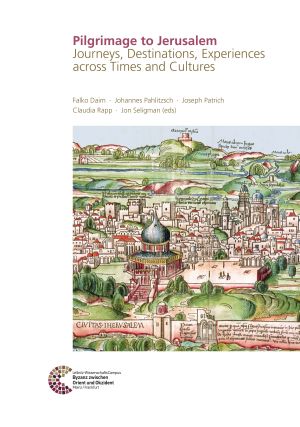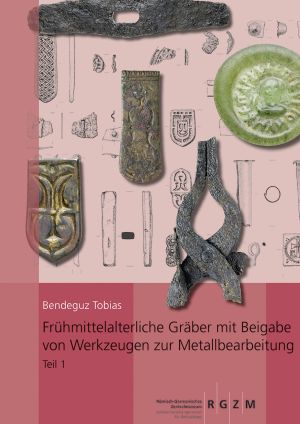Daim, Falko
Die hallstattzeitlichen Fürstengräber von Kleinklein in der Steiermark: der Kröllkogel
Die Fundstellen rund um den Burgstallkogel zwischen Großklein und Gleinstätten in der Weststeiermark zählen zu den herausragendsten der älteren Eisenzeit Österreichs und Mitteleuropas. Das Zentrum bildet die Höhensiedlung am Burgstallkogel, zu dessen Füßen sich die Sulmtal-Nekropole mit heute noch ca. 700 Grabhügeln ausbreitet.
Deutlich von ihr abgesetzt fanden sich auf der ersten Flussterrasse des Saggautals bei Kleinklein die vier reichsten Fürstengräber des gesamten Osthallstattkreises. Die meisten Funde wurden bereits im 19. und beginnenden 20. Jahrhundert geborgen. Eine erfolgreiche Nachgrabung von 1995 im jüngsten Fürstengrab, dem sogenannten Kröllkogel, gab den Impuls zur vorliegenden Neubearbeitung und Neubewertung des Prunkgrabes. Um dieses Ziel zu erreichen, schlossen sich das Universalmuseum Joanneum in Graz und das RGZM zusammen und organisierten eine interdisziplinäre Forschergruppe, die alle Aspekte des Fundes untersuchte.
Römischer Basaltlava-Abbau zwischen Eifel und Rhein
Zwischen den Städten Andernach am Rhein und Mayen in der Eifel bestand bereits in der Antike eines der großen Abbaureviere für mineralische Rohstoffe. Produkte aus Basaltlava – allen voran qualitätvolle Mühlsteine – entwickelten sich in römischer Zeit zu regelrechten Exportschlagern. Über den Rhein im großen Stil verhandelt, fanden sie ihre Abnehmer in Britannien ebenso wie im Voralpenland.
Im Mittelpunkt der Untersuchung stehen die Mühlsteinbrüche am Bellerberg-Vulkan bei Mayen. Neue Ausgrabungen und Prospektionen im Rahmen des Vulkanpark Osteifel-Projektes ermöglichen eine detaillierte Rekonstruktion der Produktionsabläufe und zeigen eine hochgradige Arbeitsteilung. Modellrechnungen unter Einbeziehung aller Funde und Befunde auch aus vor- und nachrömischen Epochen erlauben Quantifizierungen der ökonomischen Prozesse. Eine Synthese aller vergleichbaren Abbaureviere in der Alten Welt rundet die Studie ab.
Quasi Liber et Pictura: Die Tierknochenfunde aus dem Gräberfeld an der Wiener Csokorgasse – eine anthrozoologische Studie zu den awarischen Bestattungssitten
Tierknochen in awarischen Gräberfeldern werden häufig als Speisebeigaben für die Toten oder unspezifisch als „Opfer“ gedeutet. Aber warum wählten die Awaren ganz bestimmte Tiere und Tierteile aus, um sie ihren Toten in das Grab zu legen?
Henriette Baron legt die Tierknochenfunde aus dem awarischen Gräberfeld an der Wiener Csokorgasse vor, analysiert die Beigabepraxis und gibt einen detaillierten Überblick zu awarischen Tierresten des 7. und 8. Jahrhunderts – mit dem Ziel, neue Erkenntnisse darüber zu gewinnen, was die Menschen eigentlich in den Tieren sahen. Dabei wird klar: Die Interpretation als Speisebeigaben greift bisweilen zu kurz; die ausgewählten Tiere und Tierteile trugen tiefere Bedeutungen. Zudem zeichnet sich über wenige Generationen ein Wandel der Beigabensitte ab, der sich mit grundlegenden gesellschaftlichen Veränderungen in Zusammenhang bringen lässt.
Wenn man genau hinguckt, sind Tiere „wie ein Buch und ein Gemälde“ – „quasi liber et pictura“ – ein Spiegel unseres Seins, wie Alain de Lille es im 12. Jahrhundert schrieb.
Komplexe Systeme im diachronen Vergleich: Ausgewählte Aspekte der Entwicklung von drei süddeutschen Kleinräumen zwischen Früh- und Hochmittelalter
Gesellschaft und Umwelt sind komplexe Systeme in dauerndem Wandel. Diese Studie analysiert die Strukturentwicklung von drei süddeutschen Kleinräumen zwischen dem 6. und 13. Jahrhundert. Ausgehend von archäologischen, schriftlichen und geowissenschaftlichen Quellen werden durch einen systematischen diachronen Vergleich individuelle Besonderheiten und überregionale Gemeinsamkeiten herausgearbeitet. Ein spezielles Augenmerk liegt auf dem Wandel um das Jahr 1000. In dieser Zeit zeigt sich in den drei Mikrostudien eine besonders ausgeprägte Individualität. Als Ursachen dieser regionalen Sonderwege werden ökonomische, ökologische soziale und politische Prozesse diskutiert.
Zu Band 2
Zillingtal (Burgenland) – Die awarenzeitliche Siedlung und die Keramikfunde des Gräberfeldes: Teil 1
Die Bearbeitung der frühmittelalterlichen Siedlung (7.-8. Jahrhundert n. Chr.) sowie der Keramikfunde des zugehörigen Gräberfeldes konzentriert sich auf drei Schwerpunkte: awarenzeitliche Siedlungsbefunde und Siedlungsstrukturen im Karpatenbecken, Keramikproduktion und Keramikgebrauch in der Awarenzeit sowie awarenzeitliche Traditionen in Zillingtal bei der Beigabe von Keramikgefäßen ins Grab.
Bei den Siedlungsbefunden interessiert vor allem die frühmittelalterliche Wiederverwendung der römischen Ruinen. Die Auswertung des Fundmaterials konzentriert sich auf die Keramikfunde, mit denen zusammen auch die Keramikgefäße des awarenzeitlichen Gräberfeldes untersucht werden. Dazu dienen archäologische und archäometrische Analysen sowie Methoden der experimentellen Archäologie. Die gewonnene Chronologie der Grabgefäße und die anthropologischen Daten der Bestatteten bilden die Basis für die Analyse der awarenzeitlichen Traditionen bei der Beigabe von Keramikgefäßen in die Gräber.
Teil 2 hier.
Sarmatians – History and Archaeology of a Forgotten People
Ziel dieses Buches ist es, eine umfassende Einführung in die Sarmaten zu geben, das Volk von entscheidender Bedeutung in der Welt der iranischsprachigen Nomaden.
Der erste Teil des Bandes behandelt die Geschichte und Archäologie dieser Stämme von ihrer Entstehung bis zur Invasion der Hunnen, nach der die iranische Vorherrschaft im Steppengürtel durch die Macht der türkischen Nomaden abgelöst wurde. Auf der Grundlage literarischer Quellen und archäologischer Funde wird im zweiten Teil die Geschichte der Sarmaten im Karpatenbecken vom 1. bis 5. nachchristlichen Jahrhundert zusammengefasst. Ein besonderer Schwerpunkt liegt dabei auf den Steppenbeziehungen der Alföld-Sarmaten, den Neuerungen durch neue Migrationswellen und deren Auswirkungen auf die einheimische Bevölkerung. Der dritte Teil gibt einen Ausblick auf das Nachleben der Sarmaten, deren Spuren sich von Britannien bis nach China erstrecken.
Archäologie und Geschichte der Krim in byzantinischer Zeit
Obwohl die Archäologie und Geschichte der byzantinischen Krim ein gut untersuchtes Thema ist, wurden die Forschungsergebnisse jenseits des russischen Sprachraums nur schwach rezipiert.
Die hier vorgelegte Monographie des international renommierten Archäologen Aleksandr I. Ajbabin, die aus einem gemeinsamen Projekt des RGZM und der Ukrainischen Akademie der Wissenschaften hervorgegangen ist, soll dabei helfen, diesen wesentlich vom Spannungsverhältnis von Steppenvölkern und Byzantinischem Reich geprägten Raum neu und verstärkt wahrzunehmen.
Die gründlich überarbeitete und erweiterte Übersetzung des erstmals 1999 in russischer Sprache erschienenen Werkes präsentiert dem deutschen Publikum eine umfassende Übersicht über das teilweise schwer zugänglich publizierte Fundmaterial und seine Chronologie.
Das Gräberfeld beim Dorf Lučistoe
Das Gräberfeld beim Dorf Lučistoe an der Südküste der Krim ist ein einzigartiges historisches Denkmal der Völkerwanderungszeit. Von 1982-2007 wurden hier 295 Gräber des 5.-18. Jahrhunderts untersucht. Mit dem erschlossenen Quellenmaterial ist es erstmals möglich, die Bevölkerung aus dem Bergland der Krim über einen derart langen Zeitraum zu erforschen. Mit dem vorliegenden Band eröffnet das RGZM die Herausgabe des Gräberfeldes von Lučistoe, das für die Geschichte der Krim und Osteuropas von großer Bedeutung ist. Ein ausführlicher Kommentar vermittelt die chronologische und kulturgeschichtliche Einordnung der Forschungsergebnisse.
Hinter den Mauern und auf dem offenen Land: Leben im Byzantinischen Reich
Wie lebten die Menschen im Byzantinischen Reich, wie gestaltete sich ihre Lebenswirklichkeit in den Städten und auf dem Land? Was war jeweils anders? Es lohnt sich, diese Frage aus interdisziplinärer Perspektive zu stellen.
Die Ausstellung „Byzanz – Pracht und Alltag“ der Kunst- und Ausstellungshalle der Bundesrepublik Deutschland in Bonn und des Römisch-Germanischen Zentralmuseums (26.2.-13.6.2010) eröffnete für die Byzanzforschung neue Perspektiven. Die begleitende Tagung “Hinter den Mauern und auf dem offenen Land: Neue Forschungen zum Leben im Byzantinischen Reich” nahm diesen Ansatz auf und vertiefte im interdisziplinären Rahmen die Themen der Ausstellung. Im Mittelpunkt stand dabei das Alltagsleben innerhalb der urbanen und ländlichen Regionen des Reiches. Die Beiträge des Bandes führen die Ergebnisse der Mainzer Tagung zusammen. Sie widmen sich der Hauptstadt Konstantinopel, den Städten und ihrem Umland auf dem Balkan und in Kleinasien sowie dem alltäglichen Leben zur See, in Klöstern und auf dem Land.
Die byzantinischen Häfen Konstantinopels
Die Geschicke des byzantinischen Konstantinopel waren stets untrennbar mit dem Meer verbunden. Die topographische, demographische und wirtschaftliche Entwicklung der Stadt spiegelt sich in der Geschichte ihrer Häfen, die erstmalig im vorliegenden Band in ihrer Gesamtheit behandelt wird.
Zwölf Untersuchungen zu den Häfen und Anlegestellen der Stadt am Marmarameer und am Goldenen Horn – aber auch zu jenen in ihrem europäischen und asiatischen Vorfeld – schaffen unter Auswertung schriftlicher, bildlicher und archäologischer Quellen eine Synthese des aktuellen Forschungsstandes
Spätantike und Byzanz. Bestandskatalog Badisches Landesmuseum Karlsruhe: Objekte aus Bein, Elfenbein, Glas, Keramik, Metall und Stein
Die Sammlung des Badischen Landesmuseums Karlsruhe birgt einen umfangreichen Bestand an spätantiken und byzantinischen Objekten, der bislang nur in Teilen durch Publikationen zugänglich war. Bei den Artefakten und Kunstwerken handelt es sich vornehmlich um kleinformatige Gegenstände von z.T. hohem wissenschaftlichem Wert. Sie sind sowohl dem sakralen wie dem profanen Bereich zugehörig und vermitteln ein breites Spektrum des Alltagslebens sowie des Kunst- und Kulturschaffens im spätrömischen bzw. Byzantinischen Reich. Die 268 Objekte aus Bein, Elfenbein, Glas, Keramik, Metall und Stein, darunter auch einige mit Inschriften, werden in dem Bestandskatalog grundlegend dokumentiert, interpretiert und kulturgeschichtlich eingeordnet.
Menschen, Bilder, Sprache, Dinge: Wege der Kommunikation zwischen Byzanz und dem Westen 1: Bilder und Dinge
2018 zeigt das Römisch-Germanische Zentralmuseum Mainz in Zusammenarbeit mit der Schallaburg in dem prachtvollen Renaissanceschloss nahe Melk (Niederösterreich) die Ausstellung »Byzanz & der Westen. 1000 vergessene Jahre«. Beide, Byzanz und der europäische Westen, entspringen dem römischen Weltreich, doch nehmen sie schon ab dem 5. Jahrhundert unterschiedliche Entwicklungen. Während das Römische Reich im Osten Bestand hatte und sich zum Byzantinischen Reich des Mittelalters wandelte, traten im Westen gentile Herrschaften an dessen Stelle, Königreiche der Goten, Vandalen, Angelsachsen, Langobarden und Franken. Zwar blieb Byzanz zumindest 800 Jahre lang das Vorbild für die anderen europäischen Entitäten, doch kam es sehr schnell zu Missverständnissen, Meinungsverschiedenheiten und Zwistigkeiten. Die Verständigung wurde immer schwieriger – im orthodoxen Osten sprach man zumeist Griechisch, im katholischen Westen war die Verkehrssprache Latein. Auch bei der Auslegung des christlichen Glaubens war man sich zusehends uneinig. Aber immer noch bewunderte man die byzantinischen Schätze – die herrlichen Seiden, Elfenbeinreliefs, technische Wunderwerke, die vielen Reliquien, grandiose Bauwerke.
Die Wende kam 1204 mit der Eroberung und Plünderung Konstantinopels durch die Bischöfe und Ritter des Vierten Kreuzzugs. Für das bereits vorher geschwächte Byzantinische Reich bedeutete diese Katastrophe den Abstieg in die zweite politische Liga. Im Osten machten sich Kreuzfahrerstaaten breit, Venedig und Genua waren schon früher im Handel erfolgreich, jetzt hatten sie praktisch die alleinige Kontrolle.
Anlässlich dieser Schau erscheinen drei Begleitbände mit insgesamt 40 Beiträgen zu den ebenso vielfältigen wie wechselhaften Beziehungen zwischen dem lateinischen Westen und dem Byzantinischen Reich. Die Bände sind nach den Medien der Kommunikation strukturiert: Menschen, Bilder, Sprache, Dinge. Sie versammeln Beiträge namhafter Wissenschaftlerinnen und Wissenschaftler mit archäologischer, kunsthistorischer, philologischer und historischer Schwerpunktsetzung. Das vielschichtige Bild an Überblicksdarstellungen und Detailstudien gewinnt zusätzlichen Wert durch teils erstmals veröffentlichte Ergebnisse aktueller Forschungsprojekte, vornehmlich des Leibniz-WissenschaftsCampus Mainz: Byzanz zwischen Orient und Okzident sowie der byzantinistischen Forschungseinrichtungen in Wien.
Menschen, Bilder, Sprache, Dinge: Wege der Kommunikation zwischen Byzanz und dem Westen 2: Menschen und Worte
2018 zeigt das Römisch-Germanische Zentralmuseum Mainz in Zusammenarbeit mit der Schallaburg in dem prachtvollen Renaissanceschloss nahe Melk (Niederösterreich) die Ausstellung »Byzanz & der Westen. lOOO vergessene Jahre«.
Beide, Byzanz und der europäische Westen, entspringen dem römischen Weltreich, doch nehmen sie schon ab der Spätantike unterschiedliche Entwicklungen. Während das Römische Reich im Osten Bestand hatte und nahtlos in das Byzantinische Reich des Mittelalters überging, traten im Westen gentile Herrschaften an dessen Stelle, Königreiche der Goten, Vandalen, Angelsachsen, Langobarden und Franken. Zwar blieb Byzanz zumindest 800 Jahre lang für die anderen europäischen Entitäten respektierte oder akzeptierte Großmacht, doch kam es sehr schnell zu Gebietsstreitigkeiten, Zwistigkeiten und kulturellen Differenzen. Zudem wurde die Verständigung immer schwieriger - im »orthodoxen« Osten war Griechisch Verkehrssprache, im »katholischen« Westen Latein die lingua franca. Unterschiede in Liturgie und Glaubensfragen verstärkten die Differenzen oder wurden (religions)politisch zur Betonung der Verschiedenheit sogar noch unterstrichen. Aber immer noch bewunderte man das »reiche Konstantinopel« und die byzantinischen Schätze - darunter die herrlichen Seiden, Elfenbeinreliefs, technische Wunderwerke, die vielen Reliquien, grandiose Bauwerke.
Die Wende kam 1204 mit der Eroberung und Plünderung Konstantinopels durch die Kreuzfahrer. Für das bereits vorher geschwächte Byzantinische Reich bedeutete diese Katastrophe eine völlige neue Situation als ein Exilreich, dessen Kaiser und Patriarch nach Kleinasien ausweichen mussten. In einem Großteil des ehemals europäischen Byzantinischen Reiches machten sich Kreuzfahrerstaaten breit; Venedig und Genua, die durch Sonderverträge schon zuvor als Handelsmächte stark präsent waren, wurden zu bestimmenden Faktoren der westlichen Mächte im Osten.
Anlässlich dieser Schau erscheinen zwei Begleitbände mit insgesamt 41 Beiträgen zu den ebenso vielfältigen wie wechselhaften Beziehungen zwischen dem lateinischen Westen und dem Byzantinischen Reich. Die Bände sind nach den Medien der Kommunikation strukturiert: Menschen, Bilder, Sprache, Dinge. Sie versammeln Beiträge namhafter Wissenschaftlerinnen und Wissenschaftler mit archäologischer, kunsthistorischer, philologischer und historischer Schwerpunktsetzung. Mehrere Überblicksdarstellungen und Detailstudien schöpfen aus Forschungsprojekten des Leibniz-WissenschaftsCampus Mainz: Byzanz zwischen Orient und Okzident sowie dem Schwerpunkt Byzanzforschung und Mittelalterforschung der Österreichischen Akademie der Wissenschaften in Wien.
The Byzantine Harbours of Constantinople
Die Geschicke des byzantinischen Konstantinopel waren stets untrennbar mit dem Meer verbunden. Die topographische, demographische und wirtschaftliche Entwicklung der Stadt und ihre konnektive Vernetzung spiegeln sich in der Geschichte ihrer Häfen, die erstmalig im vorliegenden Band in ihrer Gesamtheit behandelt wird. Fünfzehn Untersuchungen von elf Verfassern zu den Häfen und Anlegestellen der Stadt am Marmarameer und am Goldenen Horn – aber auch zu jenen in ihrem europäischen und asiatischen Vorfeld – schaffen unter Auswertung schriftlicher, bildlicher und archäologischer Quellen eine breit dokumentierte Synthese des aktuellen Forschungsstandes.
Sasanidische Spuren in der byzantinischen, kaukasischen und islamischen Kunst und Kultur: Sasanian Elements in Byzantine, Caucasian and Islamic Art and Culture
Das Reich der persischen Sasaniden (224-651 n. Chr.) erstreckte sich über Gebiete des heutigen Iran, Irak, Aserbaidschan, Pakistan und Afghanistan. Auch die Kaukasusregionen standen unter seinem politischen Einfluss. Viele Elemente der sasanidischen Kunst und Kultur sind in angrenzenden Ländern wie Byzanz oder dem christlichen Kaukasus zu finden und lebten nach dem Untergang der Sasaniden in den islamischen Herrschaftsgebieten fort, die auf ihrem einstigen Territorium entstanden waren.
Um die fortwirkende Rolle der sasanidischen Perser und ihrer Kultur zu untersuchen, fand im September 2017 eine internationale Tagung im Römisch-Germanischen Zentralmuseum in Mainz statt. Die von WissenschaftlerInnen aus unterschiedlichen Disziplinen gehaltenen Beiträge werden in dem vorliegenden Band publiziert.
Pilgrimage to Jerusalem. Journeys, Destinations, Experiences across Times and Cultures: Proceedings of the Conference held in Jerusalem, 5th to 7th December 2017
Jerusalem ist eine Stadt, die drei Weltreligionen heilig ist: dem Judentum, dem Christentum und dem Islam. Seit frühbyzantinischer Zeit entwickelte sich die christliche Pilgerfahrt zu dieser und anderen heiligen Stätten zu einem "Massenphänomen". Tausende Christen machten sich auf den Weg zu heiligen Stätten in Palästina, Ägypten und anderen Orten, um die Heilsgeschichte physisch zu erleben und um göttliche Intervention in ihrem Leben zu suchen. Zahlreiche Reiseberichte, Pilgerführer und andere schriftliche Quellen heben wichtige Aspekte der Pilgerfahrt hervor. Darüber hinaus bieten uns viele gut erhaltene Kirchen, Klöster, Herbergen und andere Gebäude sowie die reichhaltigen archäologischen Funde, ein lebendiges Bild der Geschichte der Pilgerfahrt ins Heilige Land.
Der Doppeladler: Byzanz und die Seldschuken in Anatolien vom späten 11. bis zum 13. Jahrhundert
Das nach der für die Byzantiner vernichtenden Schlacht bei Manzikert 1071 im zuvor byzantinischen Anatolien entstandene Reich der Rum-Seldschuken war bis zu seiner Auflösung Anfang des 14. Jahrhunderts der wichtigste Nachbar der Byzantiner an ihrer Ostgrenze. Das Reich der Rum-Seldschuken vereinte Seldschuken wie griechisch-orthodoxe Einwohner und stand schon daher in einem intensiven Kontakt mit Byzanz, der sich vor allem in Handel, im Austausch von Kunstschaffenden und in Eheschließungen manifestierte. Diese sozialen und politischen Beziehungen sowie die durch ethnische und religiöse Toleranz geprägte Koexistenz der verschiedenen Völkerschaften innerhalb des Seldschukenreiches waren Grundlage für große Kunst. Gleichwohl wissen wir heute nur wenig über die Rum-Seldschuken und ihr Interagieren mit den Byzantinern, sodass bisweilen der Eindruck vorherrscht, es habe kaum einen kulturellen Austausch gegeben.
Der Tagungsband legt die Ergebnisse einer interdisziplinären Tagung vor, die vom 1. bis zum 3. Oktober 2010 im Römisch-Germanischen Zentralmuseum Mainz stattfand, um diesem Eindruck die Grundlage zu entziehen und um eine Diskussion über die Probleme der byzantinisch-seldschukischen Beziehungen zu eröffnen.
A Most Pleasant Scene and an Inexhaustible Resource Steps Towards a Byzantine Environmental History: Interdisciplinary Conference November 17th and 18th 2011 in Mainz
Was wissen wir über die Umwelten, in denen sich das Byzantinische Reich im östlichen Mittelmeerraum entfaltete? Wie wurden sie wahrgenommen und wie prägten sich Mensch und Umwelt im Laufe des byzantinischen Jahrtausends (395-1453 n. Chr.) gegenseitig? Welche Zugangswege wurden bisher erprobt, um diese Wechselwirkungen zu ergründen? Und wie könnte eine weitere umweltgeschichtliche Forschungsagenda aussehen?
Diese Fragen standen im Zentrum einer interdisziplinären Tagung, die am 17. und 18. November 2011 in Mainz stattfand. Dieser Tagungsband versammelt Beiträge von Forschern, die sich diesen Fragen von ganz unterschiedlichen Blickwinkeln genähert haben. Sie richten ihr Augenmerk auf das Aussagepotenzial traditioneller wie auch »neuer« Quellen und Methoden der Byzantinistik und Byzantinischen Archäologie für diese bislang noch wenig ergründete Sphäre. Dabei wird sichtbar, wie eng die Umweltgeschichte mit klassischen Themen der Byzanzforschung – seien sie wirtschafts-, sozial- oder kulturgeschichtlicher Natur – verwoben ist.
Das kaiserzeitliche Gräberfeld von Halbturn, Burgenland: Teil 1: Archäologie, Geschichte, Grabbrauch
Das römerzeitliche Gräberfeld Halbturn I gehörte damals zum westlichen Teil Pannoniens; die antike Großstadt Carnuntum befand sich etwa 30 km entfernt. Das Gräberfeld wurde durch systematische Ausgrabungen vollständig untersucht, was für diese Region eine Besonderheit darstellt.
Das Fundmaterial belegt eine Variabilität des Grabbrauchs, erkennbar an der Positionierung der Bestattungen und der Bestatteten sowie dem unterschiedlichen Aufwand, der in die Anlage der Gräber investiert wurde. Diese Merkmale hängen einerseits von der jeweilige zeitliche Epoche (2.-5. Jh.) ab, andererseits von der persönliche Stellung der Verstorbenen (bedingt durch Sterbealter, Geschlecht und körperliche Beeinträchtigungen). Außergewöhnlich sind vor allem die zahlreichen Säuglings- und Kindergräber.
Neben der archäologisch-typologischen Auswertung bietet die Analyse wichtige Einblicke in das damalige Leben: So ist beispielsweise ein Kindesamulett das bislang älteste Zeugnis jüdischen Glaubens in Österreich. Ernährungsweise, Krankheiten und Verletzungen – ob durch landwirtschaftliche Tätigkeiten oder häusliche Gewalt verursacht – werden ebenfalls ausführlich dargestellt, daneben stehen Überlegungen zu Tierzucht und -haltung, Kultur- und Wildpflanzen, Steinmonumenten usw. Und nicht zuletzt bietet die Fundstelle, die im Vorfeld durch Luftbildarchäologie, geophysikalische Prospektion und systematische Feldbegehungen erfasst wurde, zahlreiche weitere Erkenntnisse über die zugehörigen landwirtschaftlichen Betriebe.
Byzantinische Goldschmiedearbeiten im Römisch-Germanischen Zentralmuseum
Das Römisch-Germanische Zentralmuseum in Mainz besitzt eine Sammlung byzantinischer Goldschmiedearbeiten, die bisher nur zu einem kleinen Teil publiziert wurde und deshalb weithin unbekannt ist. Da diese Kollektion von Schmuckstücken und Rangabzeichen neben Einzelfunden auch bemerkenswerte Ensembles und zudem einige Kopien von wertvollen, leider zerstörten Originalen enthält, wird sie nun erstmals einer breiten Öffentlichkeit zugänglich gemacht. Die Objekte sind in 49 Katalognummern erfasst. Sie stammen überwiegend aus den Kerngebieten des Byzantinischen Reiches, vereinzelt aber auch aus Regionen jenseits seiner Grenzen und überdies aus einem langen Zeitraum, der sich vom späten 5. bis zum 14./15. Jahrhundert erstreckt.
Besonders hervorzuheben sind zwei Schatzfunde, darunter sogar ein münzdatierter aus Kleinasien oder dem syro-palästinensischen Raum, mehrere Kettengehänge aus kunstvoll durchbrochenen Goldmedaillons, ein ebenfalls mit feinstem opus interrasile und zudem mit wertvollsten Edelsteinen verzierter Goldarmring aus Syrien, der einzige erhaltene Zierstreifen einer Frauenkronhaube, der reich ziselierte Taschendeckel eines Mannes von mutmaßlich königlichem Rang sowie ein Ensemble römischer Glasgefäße, die wohl in Konstantinopel im 8./9. Jahrhundert mit ziselierten Goldfolien beklebt worden sind und Antiquitäten aus dem dortigen Kaiserpalast sein könnten.
Außer einem Kurzkatalog mit knappen Angaben zu jedem Sammlungsobjekt enthält das Buch eine antiquarische Würdigung dieser Goldschmiedearbeiten und die numismatische Bearbeitung des münzdatierten Schatzfundes. Darüber hinaus findet man eine detaillierte Beschreibung aller angewandten Goldschmiedetechniken, die zwei erfahrene Goldschmiedinnen und Restauratorinnen in den Werkstätten des RGZM untersucht haben. Insgesamt ist der Katalog mit neuen Meisterfotos aller Preziosen und zahllosen Detailaufnahmen sowie mit Zeichnungen sehr viel reicher bebildert als vergleichbare Publikationen.
Die Karolingerzeit in Pannonien
Der vorliegende Band geht detailliert auf eine bisher überhaupt nicht oder nur kaum bekannte Periode des Karpatenbeckens ein: die östliche Expansion des Karolingerreiches – jene knapp 100 Jahre, die zwischen dem Untergang des Awarenkhaganats und der Entstehung des ungarischen Fürstentums liegen.
Pannonia, die neue östliche Provinz des Karolingerreiches, umfasste den Großteil Transdanubiens und des Save-Drau-Zwischenstromlandes, wo sich ab der Mitte des 9. Jahrhunderts kleinere Grafschaften etablierten. Die bekannteste unter ihnen war die Grafschaft in Unterpannonien mit dem Zentrum Mosaburg, das Priwina und sein Sohn Chezil ab den 840er Jahren in Zalavár-Vársziget (Burginsel) ausbauten. In Unterpannonien, das zum Missionssprengel des Salzburger Erzbistums gehörte, wurden zwischen 840 und 870 bis zu 30 Kirchen errichtet, von denen heute bereits fünf als archäologisch identifiziert gelten. Konstantin (Kyrill) und sein Bruder, der zum Erzbischof Pannoniens ernannte Method, waren kurz in Mosaburg tätig. Ende der 880er Jahre stand hier eine Königspfalz Arnolfs von Kärnten, des ostfränkischen Königs. Er überließ Mosaburg 896 Herzog Braslav, der die Siedlung mit einer starken Wallkonstruktion umgab.
Den seit über 70 Jahren fortwährenden Ausgrabungen ist zu verdanken, dass wir heute über ein zuverlässiges Bild der Siedlungsgeschichte, der Bau- und Kunstdenkmäler, der gesellschaftlichen Hierarchie, der ethnischen Zusammensetzung und der kulturellen Verbindungen der Mosaburger Grafschaft verfügen.
Die Kraft der Tiere: Völkerwanderungszeitliche Goldhalskragen und die Grundsätze germanischer Kunst
Winzige goldene Tierfiguren, Mischwesen, menschliche und göttliche Gestalten: Um 450 n. Chr. kursierte in Nordeuropa eine ausgefeilte Bildersprache. Die Dechiffrierung dieses Codes gestattet tiefe Einblicke in eine vielfach rätselhafte Vergangenheit.
Als exquisite Schmuckstücke von höchster Qualität bilden die drei schwedischen Goldhalskragen in technischer und ikonographischer Hinsicht die Spitzenprodukte ihrer Zeit. Obwohl sie schon im 19. Jahrhundert gefunden worden sind und seitdem Forscher wie Laien gleichermaßen fasziniert haben, ist dies die erste große wissenschaftliche Monographie mit herausragendem Abbildungsmaterial über diese »Reichskleinodien«. Das Augenmerk liegt auf Fragen zu ihrer Herstellung, ihren Trägern und ihrem Zweck. Vor allem aber wird die Bedeutung der vielen Hundert figürlichen Miniaturen erläutert und damit der Zugang zu den Vorstellungswelten der Germanen in vorchristlicher Zeit erschlossen.
Frühmittelalterliche Gräber mit Beigabe von Werkzeugen zur Metallbearbeitung
Die Sitte, Werkzeuge zur Metallbearbeitung einem Verstorbenen mit ins Grab zu geben, ist bereits seit der Kupferzeit bekannt und in Europa, Asien und Afrika weitverbreitet. Der vorliegende Band versucht, diese Praktik nachzuzeichnen und dabei die geistige Kultur der jeweiligen Epoche mitzuberücksichtigen. Das Bild der archäologischen Hinterlassenschaft wird durch Schrift- und Bildquellen vervollständigt.
Die Arbeit gibt einen Überblick von der Kupferzeit bis ins Mittelalter zu allen Gräbern, in denen Schmiedewerkzeuge gefunden wurden. Einige ausgewählte Beispiele aus dem frühen Mittelalter werden in Einzelstudien eingehender behandelt.
Neben den archäologischen Befunden bieten epigraphische, ikonographische, urkundliche und historische Quellen die Grundlagen für eine neue Interpretation.
Band 2, s. hier.
Für Seelenheil und Lebensglück: Das byzantinische Pilgerwesen und seine Wurzeln
Die internationale Abschlusskonferenz des Projekts »Für Seelenheil und Lebensglück. Das byzantinische Pilgerwesen und seine Wurzeln« vom Dezember 2015 versammelte Wissenschaftlerinnen und Wissenschaftler aus den Disziplinen von Archäologie, Byzantinistik, Kunstgeschichte, Geschichtswissenschaften, Religionsgeschichte, Epigraphik und Historischer Geographie, die sich dem Phänomen der Pilgerfahrt im Byzantinischen Reich widmeten.
Die Beiträge erörtern die Zusammenhänge des byzantinischen Pilgerwesens mit der heidnischen und jüdischen Pilgerfahrt. Vor allem aber präsentieren und diskutieren sie die Praxis des Pilgerwesens zwischen »Kult und Kommerz« im sakraltopographischen und landschaftlichen Kontext einzelner Regionen und Orte des Byzantinischen Reiches von Ägypten bis Bulgarien und von Süditalien bis zum Heiligen Land.
Die Pflanzen von Schöningen
Die Speere von Schöningen belegen als die ältesten Jagdwaffen der Menschheit die Nutzung der Ressource Holz durch die Menschen vor etwa 300 000 Jahren. Es besteht eine hohe Wahrscheinlichkeit, dass eine breite Artenvielfalt von Pflanzen für die Schöninger Jäger großes Nutzungspotential hatte von der Nutzung kohlenhydratreicher Wurzeln im Winter bis zur Medizinalpflanze. Gerlinde Bigga hat in ihrer hier vorgelegten Dissertation die Pflanzenfunde der Ausgrabungen von Schöningen auf ihr Nutzungspotential für den Menschen hin untersucht und zeigt die vielfältigen Ressourcen auf, die den Urmenschen zur Verfügung standen. Auch wenn für diese Forschungen archäologische Nachweise schwer zu erbringen sind, kann sie mit dem Rückgriff auf ethnologische Untersuchungen und Berechnung des Energieverbrauchs die Nutzung von Pflanzenressourcen aufzeigen. Ihre Arbeit ist ein wichtiger Baustein, um das komplexe Verhältnis zwischen Mensch und Natur zur Zeit der Schöninger Speere besser zu verstehen und die damaligen Menschen nicht nur als Jäger kennenzulernen.



